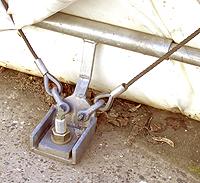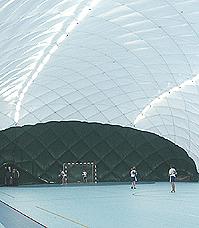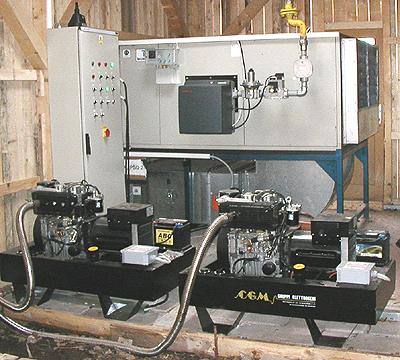Inflatable domes
There is a broad range of uses for inflatable air domes and structures, starting from various kinds of sporting facilities to even industrial uses such as storage and warehousing, as well as exhibition space and the like. It is the sporting industry, however, that offers the most amount of uses for air domes.
Technology Used in Our Inflatable Air Domes

A. Dome Anchoring
In addition to basic concrete foundations, which can be depending on local conditions a relatively expensive matter, we offer our own system of anchoring, which eliminates many costs, reduces the amount of time it takes to set up the dome, and also does not require a building permit.
The distance of each individual anchor is a standardized 2.4 or 3 meters. Everything regarding our anchoring system is composed of in such a way that it lies completely underground and unseen, important not only for safety but also for aesthetics.
Our air domes can be positioned, put up and anchored around tennis courts, swimming pools or any existing facility for that matter without causing any damage whatsoever.
For solid anchoring and dome safety we duly conduct and record ground examinations for each dome which are measured against the hardness of the anchor. In principle it is possible for an outside, local firm to reproduce our anchoring system based on our plans and documentation if requested. This applies as well to having a standard concrete foundation made, if it would be more simple for the customer to arrange it personally rather than though us.
This flexibility also relates to any possible concerns such as uneven, unusual soil conditions, limited space in periphery areas designated for roofing, or any existing fencing, all of which do not pose any compromising obstacles in terms of dome placement or assembly.

B. Dome Covering
The dome covering comprises of three or four separate layers placed on top of one another: An inner, polyester fibre-coated PVC layer; a middle insolating layer and an external protective covering. These three basic coverings are available in many different variations depending on the amount of light translucency, thermal insulation and tautness required by local conditions. This three- or four-layer system also ensures that the inner PVC remains clean and keeps its firmness and elasticity. Lastly, not a single one of our layers has any tendencies whatsoever that could lead to excessive accumulation of condensation, ensuring a bright, clean and dry internal environment inside the dome.

C. Dome Construction
Internal air pressure is created inside the dome by the blower system, causing the dome covering to expand and force itself into the external cable wiring and meshing, in so creating the dome's quilted arch.
The external cable-mesh system ensures that the PVC coverings are more evenly distributed and under less strain than domes without this important feature. These galvanized steel cables, coupled with stainless-steel connecting components, serve another role - they help to absorb all substantial internal and external static pressure [such as the wind] and distribute it along the anchoring to the ground where it is dissipated.

D. Direct Glare and Glare-Free Lighting Systems
Of up to 480 square meters can be illuminated according to the number of lights required. A standard number of 30 lights, thus covering an area of 300 square meters, consumes only 4 kW of power per hour.
The number of lights and their arrangement within the dome is very flexible; their position can be readjusted at any time and the amount of lightning can be changed and/or supplemented upon request.

E. Technical Equipment Involved in Dome Operation
All of our inflatable domes come equipped with our own blower system, which not only meets high technical demands regarding comfort and safety, but also acts as an emergency backup source of power.
F. Door components, airlocks and access halls
Revolving doors and airlocks are used to maintain a constant internal pressure in the dome.They are available in many different sizes and designs based on customer desires regarding their own specifications and aesthetics.
G. Dome storage during summer months
We offer any size of storage facility based on the exact specifications of each customer order.
If the dome is to be stored away during the summer months, it is necessary to have additional storage space built and made available for the air dome and it's various parts given the size of the building and equipment; the engine room alone, which houses all of the dome equipment, takes up an average space of about 3.5 x 3.5 meters.
Approximately 30 m 2 of storage space on average must be made available in this regard.
Each order will specify the exact specifications required regarding the size of storage space needed.












